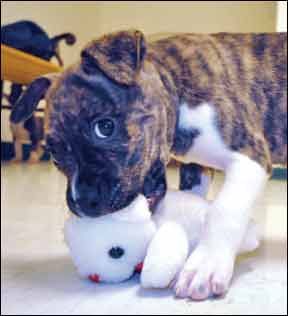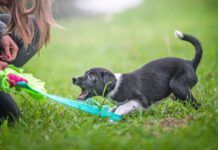Contained in every puppy’s mouth is a set of amazingly sharp little daggers known as “teeth.” Puppies explore the world with those mouths. Since you are part of your pup’s world, it is inevitable that those sharp little teeth will at some point come in contact with your tender skin during a behavior known as “puppy biting.” It hurts. So what should you do when your puppy bites you, or other family members (including children)? This is a good opportunity to train your puppy not to bite.
1. Keep it friendly. Use negative punishment – your pup’s behavior (biting) makes a good thing (you) go away. Say “Oops!” in a calm, cheerful tone of voice, stand up and turn your back on your pup for several seconds. Then interact with him again. Repeat as often as necessary. (Remember, dogs learn through repetition.) Appropriate play keeps the fun going, inappropriate biting makes the fun stop. Since your pup is all about fun, he’ll learn to inhibit his biting in order to keep you playing.
Ignore old-fashioned suggestions you might hear about holding his mouth closed, pushing his cheek into his mouth so he bites himself, or shoving your fingers down his throat. He’s not challenging your leadership when he bites you. If you respond with violence you risk damaging your relationship and making him become violent. He’s just playing, and doesn’t know his own tooth-power. By the way, yelping like another puppy in pain to communicate in “his” language causes many puppies to get more excited and bite more, not less. I don’t recommend it. Stick with a cheerful “Oops” to get your message across.
2. Tolerate less-painful mouthing. Since puppies put their mouths on everything it may be necessary to tolerate less-painful mouthing and only do your “Oops!” routine for bites that actually hurt. Over time you can shape for softer and softer bites, and finally for no mouthing at all.
3. Let the kids play with the puppy during his quiet times. All pups develop a daily routine – times of day when they are more aroused and bitey, and times when they are less mouthy. Identify the less-mouthy times of your pup’s cycle and have that be the kids’ puppy playtime. For extra insurance, be sure your baby dog has been well exercised before turning him loose on the children. Supervise all child/puppy play so you can intervene if things get out of hand, and make sure to teach your children how to respond properly if your puppy bites them.
4. Direct your pup’s mouth to appropriate bite objects. In a strategic spot in every room, keep a stash of plush toys your pup can sink his teeth into – in place of your arm. Keep a supply of stuffed Kongs in the freezer to occupy his puppy daggers. Try to anticipate his mouthy behavior and offer him a toy before he grabs your sleeve (or your flesh), but don’t hesitate to offer a toy as an alternative even after he’s latched onto you.
A flirt pole is a great toy for you or your children to safely play with your bitey puppy. This is a long, sturdy stick with a rope fastened to the end, and a toy tied to the rope. By moving the toy around you invite the puppy’s interest (and teeth) to engage a safe distance from your body parts. If necessary, you can stash your child safely behind a baby gate, in a playpen or inside a low exercise pen, flirt pole in hand, to keep her safe from wandering puppy teeth. (A good source for this training toy: bestdogkennel.com/product/TR-FP. Note: Ignore this website’s instructions for teaching “Give.” Just trade the toy for a treat.)
5. Teach “Find it!” This one is perfect for the pup who grabs your bathrobe, pant legs, or ankles as you’re walking. Rule #1: Always have treats in your pockets/on your person. Corollary to Rule #1: Have plastic containers filled with small but tasty dog treats in every room of the house (but out of pup’s reach) so you can reload when you’re running low.
As you walk, keep an eye out for puppy ambushes. When your pup approaches you with that “Gotta grab something!” gleam in his eye, toss a treat on the ground a few feet away from you and say “Find it!” Keep tossing “Find it!” treats until you can gain access to a soft toy or other chew object to offer him. Or keep playing “Find it” until he’s too tired to grab you. Mission accomplished.
Remember: It gets better after your pup is six months old and has all his adult teeth. He may still occasionally put his teeth on you, but at least it won’t hurt as much!







Yelping and stopping any play immediately (or turning away) is the best way to deal with it immediately. Secondly you want to redirect the behavior, after the initial reprimand wait a bit then offer something that the dog can chew on (nothing hard as bone for teething) and give high praise when they bite that.